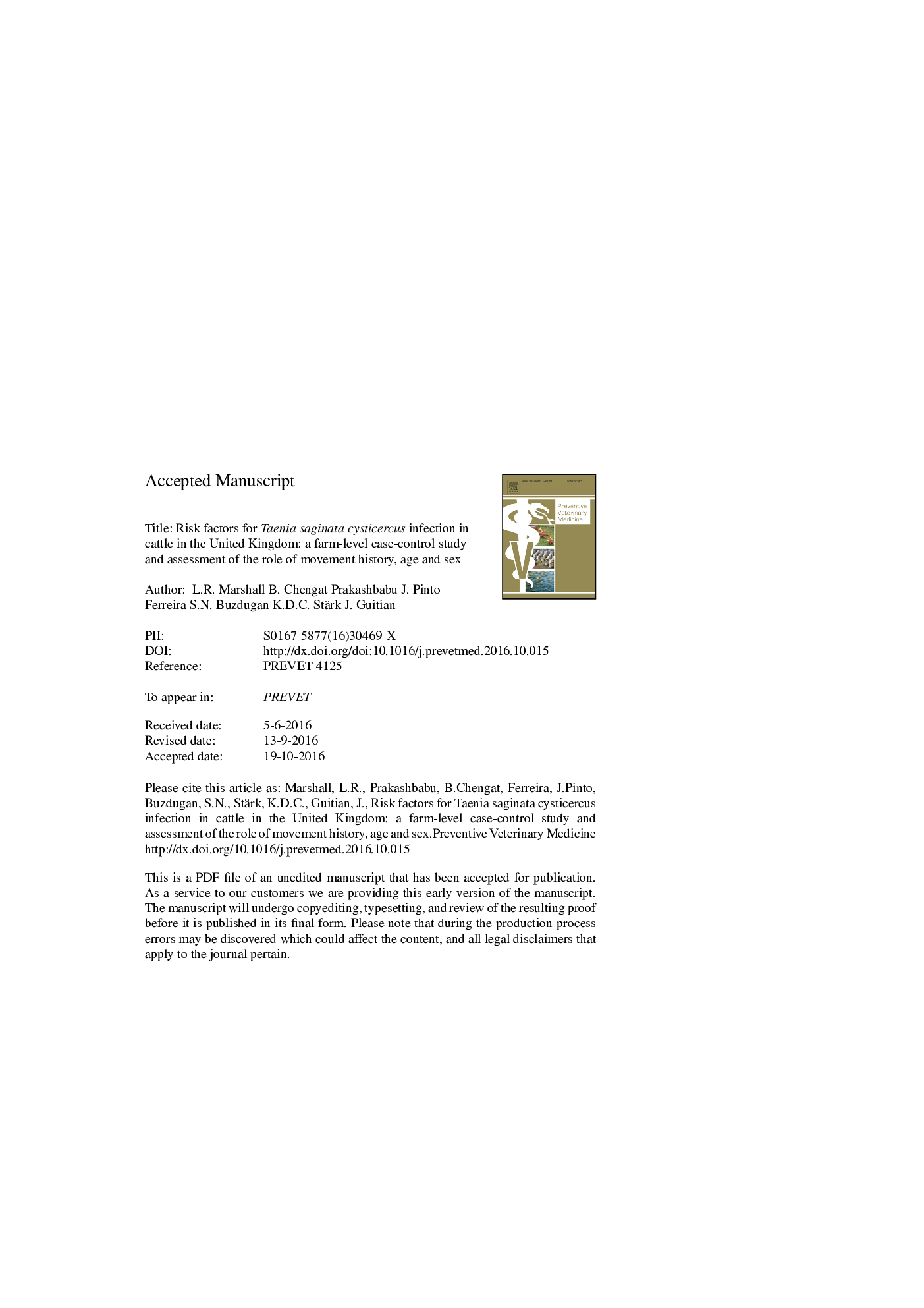| کد مقاله | کد نشریه | سال انتشار | مقاله انگلیسی | نسخه تمام متن |
|---|---|---|---|---|
| 5543682 | 1554153 | 2016 | 41 صفحه PDF | دانلود رایگان |
عنوان انگلیسی مقاله ISI
Risk factors for Taenia saginata cysticercus infection in cattle in the United Kingdom: A farm-level case-control study and assessment of the role of movement history, age and sex
دانلود مقاله + سفارش ترجمه
دانلود مقاله ISI انگلیسی
رایگان برای ایرانیان
کلمات کلیدی
موضوعات مرتبط
علوم زیستی و بیوفناوری
علوم کشاورزی و بیولوژیک
علوم دامی و جانورشناسی
پیش نمایش صفحه اول مقاله

چکیده انگلیسی
Bovine cysticercosis is caused by Taenia saginata cysticercus, the larval stage of the human tapeworm Taenia saginata. Recent European initiatives have highlighted the poor sensitivity of current surveillance for this parasite in cattle at slaughter; calling for more targeted, risk based and cost effective methods of T. saginata cysticercus detection. The aim of this study was to provide evidence that could inform such improved meat inspection activities in the United Kingdom (UK). The study included three components: (i) a farm-level case control study; (ii) the characterization of the network of movements of T. saginata cysticercus infected and non-infected animals, and an assessment of the strength of association between having passed through a farm that had previously originated an infected animal and the risk of infection; (iii) the assessment of the relationship between bovine age and gender and risk of infection. Abattoir records and cattle movement history data were used to identify farms of likely acquisition of infection (case farms) and a suitable control group. A questionnaire was used to gather farm-level characteristics and logistic regression was carried out to identify farm-level risk factors for the production of cattle found to be infected at slaughter. The case-control study provided evidence that farms situated close to a permanent potential source of human faecal contamination, and farms which used manure from animals other than cattle, were at higher risk of producing cattle later found to be infected with T. saginata cysticercus at slaughter. No other farm characteristics were identified as a risk factor for this. Analysis of the networks of animal movements showed that some individual farms played a key role as a source of T. saginata cysticercus infection; it was estimated that cattle with a history of being on a farm which previously appeared in the movement history of an infected animal were 4.27 times (PÂ <Â 0.001; 95% CI: 3.3-5.52) more likely to be diagnosed with T. saginata cysticercus infection at meat inspection. Male cattle aged 20 months or younger at the time of slaughter were found at lower risk of T. saginata cysticercus infection by comparison to other sex or age groups of cattle. These results, in combination with the consultation of experts and stakeholders, led to the conclusion that abattoir-based surveillance in low T. saginata cysticercus prevalence settings, such as Great Britain, could be made more targeted by stratifying cattle based on their individual movement history, sex and age characteristics.
ناشر
Database: Elsevier - ScienceDirect (ساینس دایرکت)
Journal: Preventive Veterinary Medicine - Volume 135, 1 December 2016, Pages 1-8
Journal: Preventive Veterinary Medicine - Volume 135, 1 December 2016, Pages 1-8
نویسندگان
L.R. Marshall, B. Chengat Prakashbabu, J. Pinto Ferreira, S.N. Buzdugan, K.D.C. Stärk, J. Guitian,